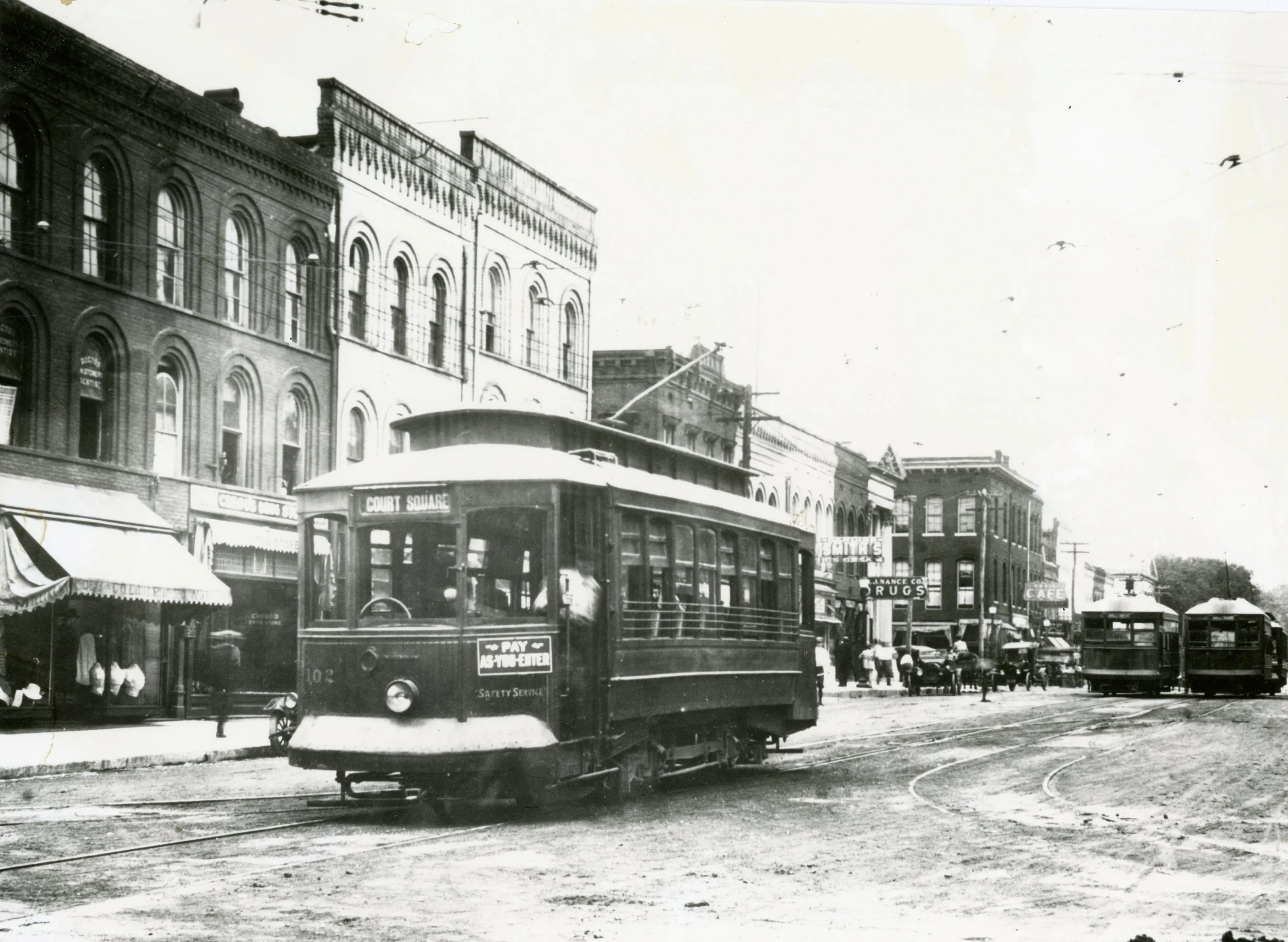Scott Doney: Anywhere but Behind a Computer: Continuing a 126-Year Legacy of Cobblery at James Shoe Hospital
Written by Truman Forehand
Photographed by Maddie McMurry
East Main Street, Downtown Jackson, 1918. A broad, not yet paved street is populated with trolley cars on their routes throughout the bustling heart of a growing town. Men in short sleeves and vests with driving caps on their heads weave their way between the cars. Women in layered dresses and cloche hats stroll the sidewalks in the background alongside the rows of small shops. Somewhere out of frame, at the corner of East Main and Shannon, is James Shoe Hospital. This scene is displayed in a photograph in the Tennessee Room at the Jackson-Madison County Library. And James Shoe Hospital, that same shoe repair shop, is still in business.
“It’s kind of a nostalgic thing,” Scott Doney, the current owner of James Shoe Hospital, said. “When you walk in, you're like, oh, okay, I know where I'm at. It smells like decades of leather and glue and polish and all that stuff. It's probably just infused deep inside these floors and walls.”
Doney has owned the shop for three years now, having bought it in 2022, and the distinct smell he mentioned is often a new customer’s first impression of the place. It smells like a bygone era, like your grandfather’s dress shoes or your grandmother’s leather purse
DB James and his wife opened the shop together on the corner of Main and Shannon in 1899 and operated continually there through two World Wars and the Great Depression before moving to the current location on East Main around 1950. Johnny Lane started work there as a shoe delivery boy at the age of 16 in 1938 and continued until he left to serve in the war in 1942. He resumed work as soon as he got back from service, though now as a fully fledged cobbler — trained by James himself. Lane was the only person the Jameses trusted to take over the business in 1960 upon their retirement, and he operated it continually until ceding control to his son Tommy upon his own retirement in the 2000s. The younger Lane kept going, repairing shoes on East Main, until 2022. That brings us to Scott Doney and the present day.
Though the shop itself is old, the craft — working with shoes, or cobblery— is not one that Doney himself came to by heritage or family tradition. He came to it later in life as a second career, a pivot driven by a passion for a trade that was falling out of favor and had been for some time.
“You can’t find anybody that wants to learn this skill,” Johnny Lane told The Jackson Sun in 2004. “It takes time to learn it, and most young people today are more interested in computers.”
Ironically, the very technology that Lane feared would spell the death of his ancient craft is, in a roundabout way, what would bring the shop its new caretaker nearly 20 years later.
“I just couldn’t sit behind a computer anymore,” Doney said.
“Because he cares so deeply, Doney does his best to keep up with what the elders of the trade have done and what he can continue to learn from them.”
Now 47 years old, Doney says that working with computers was the only job he had ever had before the shop. His dad purchased a home computer when he was a child, one of the first in their neighborhood in the 1980s, and he learned that skill early. In 2020, though, burnout and COVID-19 pushed him to consider a different lifestyle and a different perspective.
“During COVID, there was a lot of YouTube watching and stuff like that. So I ran across a bunch of those guys who were cobblers that were just kind of filming themselves, doing their thing and talking,” Doney said.
That duality of computers — both to push a man away from sitting behind one and to teach him the skills to do something else — might have saved James Shoe Hospital. After learning through YouTube and from an older cobbler in Memphis who acted as a mentor, Doney was interested in a long-term career shift.
“I saw that [Tommy Lane] was selling this shop, and I called him up,” Doney said. “I was like, I don't have a background in this. I enjoy it. Is it possible I could buy it and learn it like that? He said, ‘Oh yeah, come on up. I'll show you how it all works. I'll get you familiar with the machines.’ That was three years ago, and you know, knock on wood, it's going well. I really like it.”
The road that Doney took to learning the craft, however, would not historically have been how the trade was passed from one person to another. In fact, it would have looked a lot like the way that the previous generations of James Shoe Hospital handed it down. Johnny Lane was a longtime apprentice to DB James, and Tommy Lane learned the business under the tutelage of his father. The 21st century and the decline of handworking trades have changed the landscape, though.
“Cobblers, we're pretty few and far between these days,” Doney said. “I mean, at one time, there were a lot of them. But now I think I saw an article that said there were, like, 4,000 left in the US, which, when you think about it, is really not that many. Because New York has a bunch, Chicago has a bunch. They're concentrated. So when you get outside of those bigger cities, it gets pretty few and far between from shop to shop.”
That changing landscape can, of course, be attributed to a number of factors. Lane’s earlier complaint that technology is drawing away people who might otherwise learn a trade is echoed across many fields today. For cobblers specifically, though, it’s not just that the economy or the workplace has changed — shoes themselves have changed.
“Sometime around the ‘80s, there was a big push on basically glue-constructed tennis shoes that aren't meant to be resoled. You wear them until they wear out and you toss them and buy a new pair,” Doney explained. “I think a lot of cobbler shops probably suffered from that.”
Because he cares so deeply, Doney does his best to keep up with what the elders of the trade have done and what he can continue to learn from them. Anytime he travels to a new town, he looks up the cobbler. And if there is one, Doney will visit their shop to sit, observe, and do his best to preserve the proud trade he has adopted.
“I hate that there's a lot of cobbler shops where the cobbler’s getting up in age and about ready to retire, and there's nobody underneath,” he said. “So once they retire and they close, that's it. Another one's gone.”
In that sense, James Shoe Hospital is an outlier. A cobbler shop that has operated continually since 1899 and is still going strong. In another sense, though, Doney is hopeful both for Jackson and for cobblery in a broader sense. Just as the same new technology that could seemingly have doomed his craft is also what brought him to the trade, he sees it bringing other newfaces and new voices. There is an online community of cobblers that is growing and thriving, keeping an old tradition alive through a modern medium.
“As old a craft as it is, there's always new stuff to learn,” Doney said. “So it's just neat to see what everybody's doing, and with YouTube and all that stuff, you can see that.”
The shoes he gets today look different from the ones that DB James worked on in 1918 or the ones that Johnny Lane worked on in 1960. There’s plastic, vinyl, nylon, glue, foam, and assorted synthetics. But the innovation that has sustained the profession for centuries is still going strong. As the shoes have changed, so too have the solutions and repairs required: new glues, new stitching, new techniques. James Shoe Hospital’s daily operation is a meeting of the old and the new, of wistful nostalgia melding with the innovation necessary to thrive in the modern era, of working on 60-year-old cowboy boots one minute and six-month-old sneakers the next. Newness and tradition live side-by-side.
It’s important, then, that the shop is a family business, even if the actual family involved has changed over the decades and the turns of two centuries. Doney does not speak of himself, personally, as the owner of the shop, but instead of being a collective “third family to own the shop.” His daughter Lena, on summer break before starting college in the fall, works behind the counter with him. The shop still bears the name of the original owners, of course, a detail that Doney said was a condition presented by the Jameses to Johnny Lane in 1960.
“They told him, ‘The only thing I ask is that you don’t change the name.’”
Over time, the name of the shop has come to be associated with the man behind the counter, no matter who he is.
“Probably daily, people come in and call me James,” Doney said. “And I just go, ‘Yeah?’”
He identifies with the shop, agesture that makes sense for a man who works at a craft that involves putting some of himself into every pair of shoes he repairs by hand. The sands of time have covered over this once essential profession, as shoes have become rebuyable instead of repairable, but for those who remain, it has only ever beena labor of love.
In the three years since he took over, Doney has seen foot traffic around the shop increase. He’s seen new shops open in previously empty buildings around his own, a change he welcomes for the increase in vibrance and people walking outside his doors.
East Main Street, Downtown Jackson, 2025. The trolley cars are gone, replaced by cars and trucks with computers in their dashboards on paved streets. Men and women walk together in sneakers and shorts and ballcaps. Somewhere, alongside new shops and this new increase of pedestrian passersby, is James Shoe Hospital.




